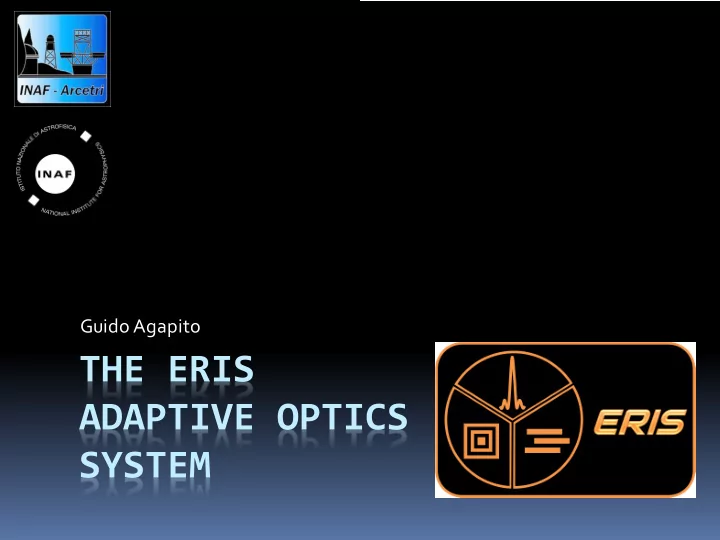

Guido Agapito THE ERIS ADAPTIVE OPTICS SYSTEM
ERIS ERIS, the Enhanced Resolution Imager and Spectrograph, is an instrument for the Cassegrain focus of UT4 at the ESO VLT. It comprises: § two science instruments : ú NIX : IR imager providing diffraction limited imaging, Sparse Aperture Masking (SAM) and pupil plane coronagraphy capabilities from 1 to 5 μm. ú SPIFFIER (SPectrometer for Infrared Faint Field Imaging with Enhanced Resolution): near-IR (1.08-2.43 μm) integral field spectrograph (upgraded version of SPIFFI). § An Adaptive optics module . § A Calibration Unit (CU). 2
ERIS – Consortium • Max Planck Institute for Extraterrestrial Physics ( MPE , with contributions from ETH Zürich) • INAF (Arcetri, Padova, and Teramo) • UK Astronomy Technology Centre ( ATC ) • ESO 3
ERIS – Conceptual scheme AO module Scientific instruments 4
ERIS – AO module The AO module has wavefront sensing and real-time computing capabilities. It interfaces to the AOF infrastructure and provides the following observing modes: § LGS-mode: a WFS provides high-order AO correction using a LGS on-axis (T-WFS) and a second WFS provides low-order correction using a NGS (R-WFS) in the patrol field (R≤1’). § NGS-mode: a WFS Visible light provides high-order AO correction using a NGS (R-WFS) in the patrol field; Laser light IR light 5
ERIS – AO module design Folding mirror VIS dichroic IR/VIS dichroic 6
ERIS – AO performance Performance w/ full error budget Performance from E2E simulations Top level requirements On-axis NGS (seeing 0.87”) 7
ERIS – NGS-mode contrast TLR : “… a contrast (5σ after post-processing) of more than 10 magnitudes in L’-band and M’-band shall be achieved over at least the radial range 3-7λ/D …” L’ band: • Star mag. 5 • BG mag. 3.9 𝐵𝐸𝐽 𝑇𝑂𝑆 𝑂 )*+,-. = 𝑜 0122 3 + 2 𝑂 )*+,-. + 2 𝑂 6.+7 + 2 𝑂 89 𝜏 0122 Where 𝜏 0122 (𝑠) = RMS of difference between two uncorrelated PSF in the bin, N planet , N star , N BG are respectively the photon noise, from the planet and the star, and the sky background noise in the considered bin. 8
ERIS – Pyramid WFS upgrade Performance NGS-mode Pyramid Pupil relay lens WFS Light from the Rotating optical mechanism NGS/LGS Periscope beamsplitter Pyramid layout Tech. viewer Fast Steering Mirror Focal reducer Relay lens ADC Derotator Beam-splitter 9
ERIS – schedule 10
Recommend
More recommend